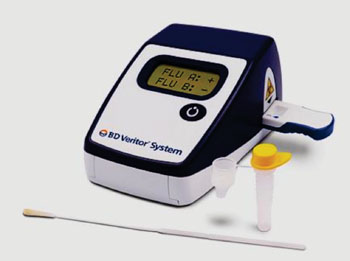Field Performance for Rapid Detection of Influenza Virus Analyzed
By LabMedica International staff writers
Posted on 27 Sep 2016
Clinical differentiation of influenza A virus from infections caused by influenza B virus and the other viruses is unreliable, however effective antiviral treatment is only available for influenza A virus infections and must be administered early in the course of disease to be effective.Posted on 27 Sep 2016
Historically, rapid influenza virus antigen diagnostic tests (RIDTs) were simple to perform but were insensitive, particularly for recently introduced strains of influenza A virus and influenza B virus. In contrast, the more recently introduced digital immunoassays (DIAs) have improved analytical performance.

Image: The BD Veritor system for rapid detection of Influenza A + B (Photo courtesy of Becton, Dickinson and Company).
Microbiologist at Medical Faculty of Istanbul University conducted single-blinded cross sectional study nine different family medicine centers in Istanbul, Turkey between 01 November 2014 and 01 May 2015. Nasopharyngeal specimens were collected by the physicians at the time of the initial patient visit, typically within three days of the onset of symptoms. Two specimens were collected, from each patient: one for real-time polymerase chain reaction RT-PCR and one for the point-of-care (POC) test.
The POC test used was the BD Veritor System for Rapid Detection of Flu A + B (Becton, Dickinson and Company, Franklin Lakes, NJ, USA). It is a rapid digital chromatographic immunoassay for the direct, qualitative detection of influenza A and B viral nucleoprotein antigens from nasal and nasopharyngeal swabs of symptomatic patients and differentiates influenza A and B viral antigens from a processed sample using a single device. The RT-PCR results were reported with the analysis of amplification plot in the Light Cycler 480 II (Roche Diagnostics, Mannheim, Germany).
A total of 122 patients out of 238 were positive for influenza by RT-PCR including 42 with influenza A H1N1, 11 with influenza A H3N2, two with influenza A undetermined strains, and 68 with influenza B. One patient’s PCR test was positive for both influenza A and B but the Veritor test was negative for both viruses. The clinical sensitivity and specificity of the Veritor test in all age groups was determined to be 80% and 94%, respectively. Positive predictive value was 93% and the negative one was 81%.
The authors concluded that the field performance of the rapid influenza test, the BD Veritor System for Rapid Detection of Flu A + B, was high and found to be useful with respect to rational antiviral use, avoiding unnecessary antibiotic usage and the management of cases by the family physicians. The study was published on September 9, 2016, in the journal BMC Infectious Diseases.
Related Links:
Istanbul University
Becton, Dickinson and Company
Roche Diagnostics














